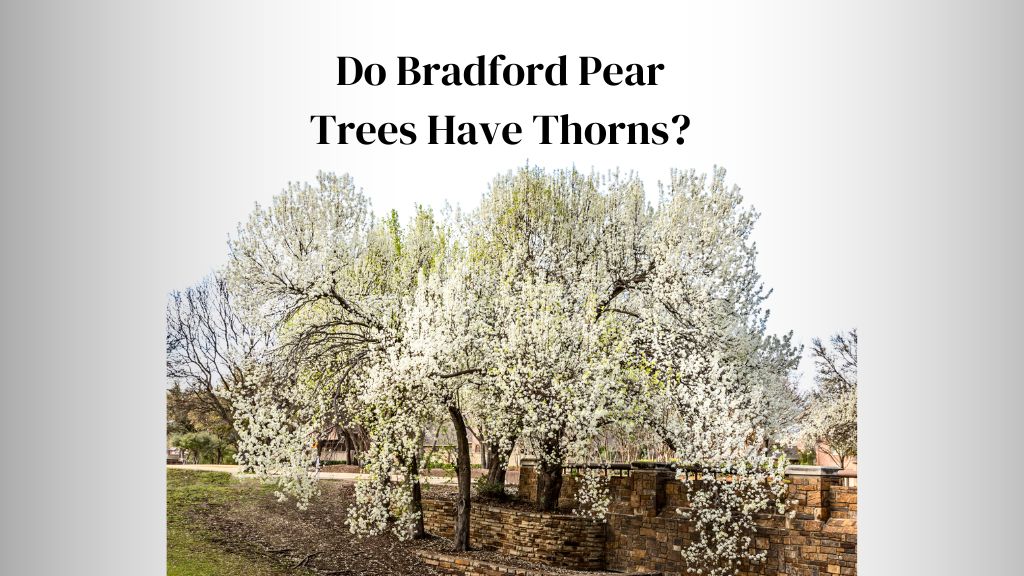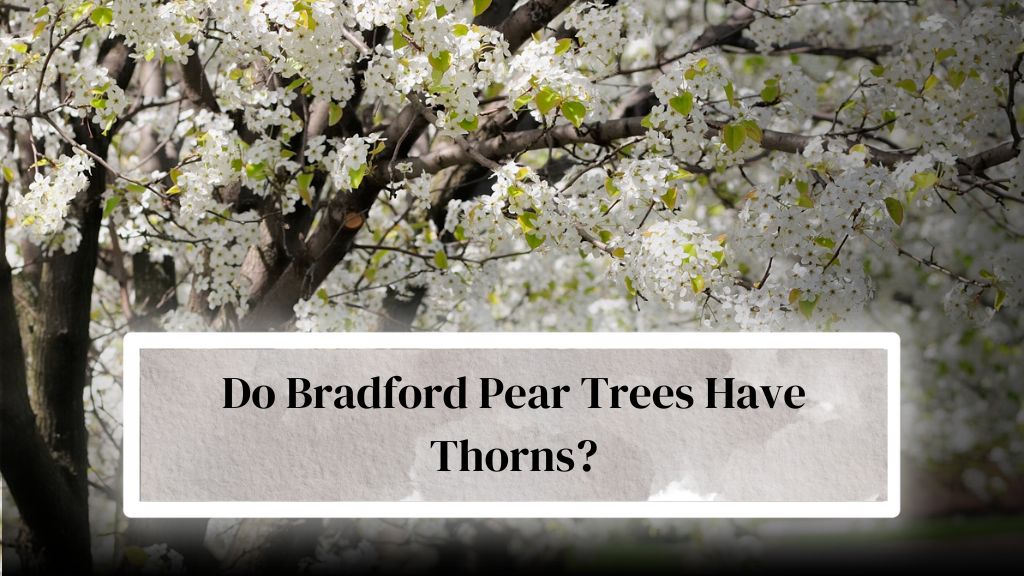
You may have heard conflicting information about whether Bradford Pear trees have thorns. Some say they do, while others say they don’t. In this article, I will answer the question ‘Do Bradford Pear Trees Have Thorns?’ and tell you ‘Why Do Bradford Pear Trees Have Thorns.’
Further, we’ll also be learning the difference between thornless and Thorny Bradford Pear trees, along with their pros and cons. First, the basic question is: Do Bradford Pear Trees Have Thorns?
Do Bradford Pear Trees Have Thorns?

I have seen Bradford Pear trees and noticed that they have thorns. However, not all varieties of the tree have thorns.
When trees are exposed to external threats, such as browsing by herbivores or damaging their bark, they activate their defense mechanism. One of how trees protect themselves is by developing thorns or other physical barriers.
There are arguments both for and against Bradford Pear trees having thorns. Some claim that the presence of thorns prevents animals from harming the tree.
Others contend that the thorns are an annoyance and potentially dangerous to humans and animals. We know that thorns on Bradford Pear trees can grow up to an inch long. Only trees that have undergone hybridization have these thorns; other trees do not.
Hybridization occurs when two different species of trees are crossed to produce a new hybrid species. The thorns in Bradford Pear trees are believed to have originated from the Callery Pear, a related tree species that has thorns naturally.
Where Are the Thorns Located on the Tree?
You’re not the only one who has ever questioned where the thorns on a Bradford Pear tree are. Thorns can be seen on the tree’s leaves, branches, and trunk, among other tree parts. Depending on the type of tree, the thorns’ size and shape may also change.
Are the Thorns Harmful to Humans and Animals?
You may be worried about the possible harm the thorns could do if you’re considering planting a Bradford Pear tree. Even though the thorns can hurt if they prick your skin, they are typically not dangerous. Animals, however, can be at risk if they consume the thorns.
Different Varieties & Parts of Bradford Pear Trees
As I mentioned earlier, not all varieties of Bradford Pear trees have thorns. Some of the most popular tree varieties include the Cleveland Pear, the Aristocrat Pear, and the Bradford Pear. The Cleveland Pear and Aristocrat Pear do not have thorns, while the Bradford Pear does.
If you are still wondering where the thorns may be located on the tree, here is a breakdown. The tree’s trunk may have thorns, although they are usually small and difficult to see. The tree branches may have larger thorns, which are more visible. Finally, the tree leaves may have small spines along the edges.
Why Do Bradford Pear Trees Have Thorns

Natural Defense Mechanism
Firstly, we should know that thorns are a natural defense mechanism many plants develop to protect themselves from predators. Bradford Pear Trees are no exception. I have found that the thorns on Bradford Pear Trees are modified branches that have become hardened and pointed over time, making it difficult for animals to graze on them.
Protection Against Herbivores
According to studies, thorns can be a useful tool for keeping herbivores away. According to research done by ecologists at the University of Wisconsin, Madison, deer are less inclined to graze on thorny trees and shrubs than non-thorny ones. Therefore, planting a few Bradford Pear trees might be a good idea if you want to protect your trees from herbivores.
Environmental Stress
Another reason Bradford Pear Trees have thorns could be environmental stress. I have found that trees growing in harsh environments, such as arid regions or high altitudes, often develop thorns to survive. Bradford Pear Trees growing in urban areas might also be exposed to pollution and other environmental stressors that could cause them to develop thorns.
If you want, you should consider reading this: Why Are Bradford Pear Trees Bad For The Environment? ( 7 Reasons)
Hybridization
Hybridization is another factor that could be responsible for the thorns on Bradford Pear Trees. I have learned that Bradford Pear Trees are a hybrid between two different species of pear trees, and as a result, they might have inherited the complex trait from one of their parent species.
Genetics
Lastly, genetics could also play a role in the development of thorns on Bradford Pear Trees. I have found that some trees might have a genetic predisposition towards developing thorns, regardless of their environment or hybridization.
Thornless Varieties of Bradford Pear Trees
While Bradford Pear Trees are known for their thorns, thornless varieties are also available. In this section, I will discuss how to identify these varieties, differentiate between thornless and thorny Bradford Pear trees, and discuss the advantages and disadvantages of thornless varieties.
Identification of Thornless Varieties of Bradford Pear Trees
Thornless Bradford Pear Trees can be identified by their smooth branches and lack of thorns. They may also have a different leaf shape or color than their thorny counterparts. I have found that some popular thornless varieties include ‘Aristocrat,’ ‘Chanticleer,’ and ‘Cleveland Select.’
Differentiating Between Thornless and Thorny Bradford Pear Trees
Examining the branches is one way to differentiate between thornless and thorny Bradford Pear Trees. As mentioned earlier, thornless varieties will have smooth branches, while thorny varieties will have branches with thorns. You can also look at the leaves and flowers to identify differences in shape or color.
Advantages and Disadvantages of Thornless Varieties
Advantages
The main advantage of thornless varieties of Bradford Pear Trees is that they are less likely to cause injury to people or animals. This can be especially important in urban areas or places with many pedestrians or pets. Additionally, thornless varieties may be more aesthetically pleasing to some people, as they do not have sharp thorns that can detract from the tree’s beauty. However, if you’ve animals, consider reading the article on: Are Bradford Pear Trees Poisonous To Cattles?
Disadvantages
However, there are also some disadvantages to thornless varieties. We should know that thorns can serve as a natural defense mechanism for trees, and without them, thornless varieties may be more vulnerable to herbivores or other pests. Additionally, some people prefer the look of thorny trees and may find thornless varieties less interesting.
Conclusion
This article gives you a rough idea on the topic ‘Do Bradford Pear Trees Have Thorns?’ and from now on, you can differentiate between thornless & throne Bradford pear trees. If you find this article helpful, please share it with us.
Your share will not only help people learn whether this tree develops the throne or not but also the advantages and disadvantages of thornless varieties. Also, check our other helpful guide on Bradford pear tree care & management shared on this website. See you in the next post. Till then, take care and goodbye.
